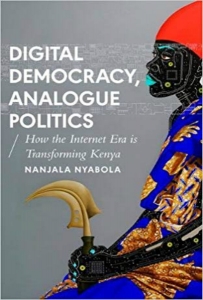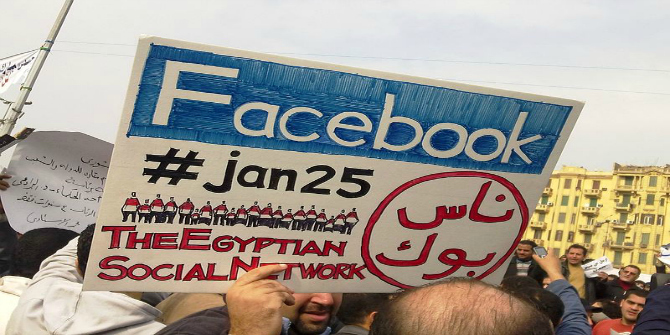In Digital Democracy, Analogue Politics: How the Internet Era is Transforming Kenya, Nanjala Nyabola challenges existing scholarship on ‘tech in Africa’ by exploring how state agency and the politics of offline spaces have consequences for what happens online. This beautifully written book is a must-read for all researchers and journalists writing about Kenya today, recommends Priyanka deSouza.
Digital Democracy, Analogue Politics: How the Internet Era is Transforming Kenya. Nanjala Nyabola. Zed Books. 2018.
 Find this book (affiliate link):
Find this book (affiliate link): ![]()
Kenya is often dubbed Africa’s ‘Silicon Savannah’ because of the success of digital innovations such as Ushahidi, a crowd-sourcing platform for social activism, and the widespread use of Mpesa, mobile money. The Kenyan government has celebrated this ‘branding’. A perhaps unintended consequence (for the state) of the celebration of this narrative has been a dynamic digital space, in which many Kenyans, whose voices would not otherwise be heard in analogue public spaces, have been able to question the social and political systems of the country, as well as connect with like-minded individuals to articulate new radical political agendas. Although the state has tried to stifle these conversations through various means such as the 2016 Information Communication and Technology Bill, its commitment to project itself as liberal and ‘high-tech’ has allowed these digital spaces to flourish. How should the story of these spaces be told?
In her debut book, Digital Democracy, Analogue Politics: How the Internet Era is Transforming Kenya, Nanjala Nyabola argues that current scholarship about ‘tech in Africa’ tends to be framed in overly simplistic developmentalist terms, and fails to account for state agency and the politics in offline spaces that have everything to do with what happens online. She pushes back methodologically against these reductive narratives by telling an empirically thick, descriptive story of the terrain through which power operates in Kenya (Africa is not a country), and the way in which it sizzles and congeals at the intersection of the traditional public sphere and the extension of this sphere online. She deliberately refuses to engage with the naive, optimistic view that more technology = more democracy.
Nyabola takes the Habermassian view that communication is the basis for human behaviour. It is in the public sphere that ideas are negotiated and a national narrative is produced. Whose voice counts in the public sphere? Is the public sphere restricted to the formal patriarchal political sphere, or do the ideas and opinions generated in other spheres that are shaped by social and cultural boundaries matter as well? If so, how are they made to matter? Nyabola argues that the media has an outsized role as a site that enables deliberation in and across these spheres to produce a more representative society.
Image Credit: ‘Usahhidi J2ME App’ by Erik (HASH) Hersman licensed under CC BY 2.0
Nyabola demonstrates that the Kenyan media’s structure of ownership and its reliance on state-sponsored advertisements have shackled the narrative it chooses to tell to a very specific bourgeois nation-building story. This story fails to reflect the lived reality of most Kenyans. Importantly, she dwells on the difference in content in inward-facing local-language media as well as that of the formal, outward-facing English media in constructing diverse stories. I would have loved to have seen a more detailed characterisation of local-language media and other forms of non-traditional means of communication, such as plays, fiction, music etc, which the author mentions in passing, in the crafting of different national narratives. Given these offline conditions, digital platforms offer Kenyans a low-barrier alternative to tell their stories and insert themselves into the public sphere.
The first part of Nyabola’s book describes the political conditions at the time of the Kenyan 2007 election, which primed the country for digital change. The collapse of the National Rainbow Coalition dashed the hopes of the Kenyan public, who believed that the corrupt years of former President Daniel arap Moi’s regime were over. Instead, the perception that the government had become increasingly ethnicised polarised the public. When irregularities in the 2007 election were discovered during its broadcast, simmering tensions exploded and violence ensued. Live broadcasts were banned, muzzling the Kenyan press. An educated, concerned diaspora and a public hungry for news were thus caught between the fury of an international press and the tame, self-censored Kenyan media. The internet served as a space for information dissemination during this critical period. Nyabola states that it was at this time that blogs that had formerly been apolitical became sites of heated political debates. The internet thus created space for new discourses, and allowed for new imaginings of statehood and identity.
Nyabola traces the evolution of these discourses from the time of the 2007 election to the 2017 Kenyan election in Part Two of her book. She mostly focuses on the discourse created by the community #KOT: Kenyans on Twitter, although she does touch on the growing use of other platforms such as Whatsapp, Facebook etc. Nyabola describes the ways in which KOT have exerted agency over the telling of their stories, such as in pushing back against the specific framing of stories by foreign media with humour, creativity and satire, as well as against official narratives, thus holding the government accountable. Interestingly, she describes ‘super users’ on Twitter (users with large numbers of followers) as thought leaders who have the power to shape and amplify online discussions. I would have loved to have learned more about who these leaders are and how they have shaped the landscape of KOT.
Nyabola focuses on Twitter because she argues that it allows users to share public content and engage with each other, in comparison to Facebook where engagement is limited to a friend’s circle. Nyabola acknowledges that digital illiteracy and infrastructure barriers, such as a lack of electricity or an internet connection, nonetheless limit the number of people who are online in Kenya. She notes that in 2018 there are now one million largely English-speaking, urban Kenyan Twitter users and ten million Whatsapp users in a country of around 50 million. It would have thus been interesting to see a systematic comparison of the usage of these platforms, and their respective relationship with analogue political agendas.
Although Nyabola is optimistic about the political potential of Kenya’s digital space, she is not uncritical of the structure of the space itself. She recognises that many of the power hierarchies in offline spaces tend to be reproduced online. For example, she notes that women are still subject to more harassment online than men. She spends a chapter detailing the organising of radical Kenyan feminists on the internet on important issues such as domestic violence, the harassment of women in public spaces and the adequate representation of women in Parliament in line with the Constitution, as well as the backlash this organising has incited. She dissects the failure of traditional organisations working to empower women to take these online conversations about feminism seriously. She stresses that change can only happen when digital spaces work in tandem with analogue politics.
Nyabola makes clear that technology is never neutral. The platforms on which discourse plays out in the digital world are owned and controlled by profit-driven North American companies. Thus people with money can game these platforms: for example, by creating bot farms to foist content on users, run smear campaigns, spread false information and shape users’ opinion without their consent. Russia is suspected of engaging in such digital warfare during the 2016 US elections, and we have also seen how companies such as Cambridge Analytica weaponised the data of Facebook users to shift public opinion during this and the 2016 Brexit referendum.
Nyabola argues that the contours of these platforms have not been adequately studied in the Global South. She writes that this is because of the ‘sociology of absence’: the idea that because the story of these platforms play out in Western media, the experience of using these platforms in Kenya is irrelevant. However, Nyabola demonstrates that this simply is not the case. Cambridge Analytica are believed to have used the 2013 Kenyan elections as a testbed for the methods they were later to deploy elsewhere. If the world had been paying attention, the current crises regarding interference in the US election and Brexit referendum might have been averted. Nyabola states that in the 2017 Kenyan election, both the incumbent party and the opposition in Kenya relied on IT experts during their campaigns. She warns that the use of these digital modes of shaping public opinion and the lack of any data privacy laws have ushered in a new frontier of neo-colonialism, which merits further study. Interestingly, however, she argues that perhaps an advantage of Kenyans using a platform that was not designed for them is that these spaces are blind to ethnicity. This has made it possible for people to coalesce across ethnicities.
Finally, in the third part of the book, Nyabola ends with an excellent discussion of the 2017 elections. Despite the Kenya Integrated Election Management System (KIEMS) that was put in place to prevent the manipulation of election results, the massive irregularities that took place resulted in the Supreme Court annulling the election results. Nyabola provides a detailed description of how KOT galvanised itself to take photos of results at polling stations to compare with the broadcast results, and played a key role in holding the process accountable in the public sphere. Through this example, she shows that no amount of technology can ever replace the intentions of the state.
What this book makes clear is that Kenyans are determined to reclaim the agency to shape their own stories. Nyabola has beautifully told the story of how they have done this so far via digital platforms. This is a must-read book for all researchers/journalists writing about Kenya, who will be relaying an incomplete narrative if they do not take these online conversations seriously.
Note: This review gives the views of the author, and not the position of the LSE Review of Books blog, or of the London School of Economics and Political Science. The LSE RB blog may receive a small commission if you choose to make a purchase through the above Amazon affiliate link. This is entirely independent of the coverage of the book on LSE Review of Books.









1 Comments